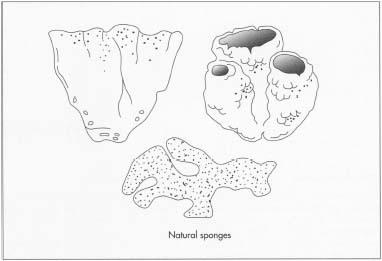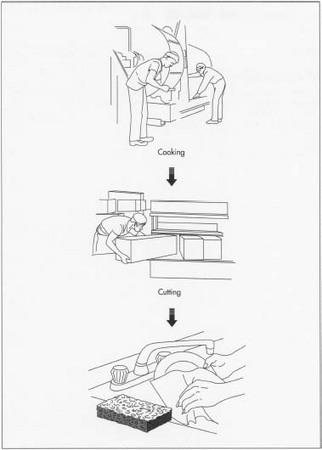Sponge
Background
There are many different varieties of sea sponges, and these come in widely varying shapes and sizes. They can be very large, and grow in elaborate branched formations, or be round and small, or grow flat or in a tube shape. Some are brilliantly colored, though they fade when they are harvested. Sea sponges are thought to have evolved at least 700 million years ago. They are among the simplest animal organisms, having no specialized organs such as heart and lungs, and no locomotion. Sponges live attached to rocks on the sea bed. Their bodies consist of skeletons made of a soft material called spongin, and a leathery skin broken by pores. The sponge eats by pumping seawater in through its pores. It filters microscopic plants from the water, and expels the excess water through one or more large holes called oscula. It also absorbs oxygen directly from seawater. Sponges are slow-growing, taking several years to reach full size, and some live for hundreds of years.
Sea sponges were used since ancient times in the Mediterranean region where they are most common. Roman soldiers each carried a personal sponge, which served the purpose of modern toilet paper, and they were certainly used for other purposes as well. Artificial sponges were first developed by the Du Pont company—a leader in synthetic materials manufacturing industry that also invented nylon—in the 1940s. Three DuPont engineers patented the cellulose sponge process, and DuPont held onto the secret until 1952, when it sold its sponge technology to General Mills. In the second half of the twentieth century, cellulose sponges rapidly replaced the natural sponge for most common household uses.
Raw Materials
Many different types of sponge are harvested and dried for human use, but the most common one is the Spongia oficinalis, also known as the glove sponge. Another common type used commercially is the sheep's wool sponge, or Hippospongia canaliculata. Synthetic sponges are made of three basic ingredients: cellulose derived from wood pulp, sodium sulphate, and hemp fiber. Other materials needed are chemical softeners, which break the cellulose down into the proper consistency, bleach, and dye.
Harvesting Sea Sponges
To gather natural sponges, specially trained divers descend into sponge-growing waters with a large two-pronged hook and a string bag. Traditional sponge divers in Greece used no special breathing equipment. The men of seaside villages were trained from childhood and were expert deep water divers. The sponge industry in the United States centers around Tarpon Springs, Florida, a community that was founded by Greek immigrant divers. Today's sponge divers use modern diving equipment such as wet suits and oxygen tanks. The divers pry sponges off the rocks or reefs where they grow, and bring them up in their string bags. The divers pile the sponges on the deck of their boat and cover them with wet cloths. The animals die on the boat, and their skins rot off. After the skins have decayed, the harvesters wash the sponges and string them on a long, thin rope to dry in the sun. After they have dried completely, the harvesters wash the sponges several more times. This is all the preparation the sponges need to be ready for sale.

The Manufacturing
Process
The steps necessary in the manufacture of synthetic sponge is discussed below.
- The cellulose used for sponges arrives at the sponge factory in large, stiff sheets. Workers take the sheets and soak them in a vat of water mixed with certain chemical softeners. The cellulose becomes soft and jelly-like. Then workers load the cellulose into a revolving mixer, which is a large rotating metal drum. Workers add the sodium sulphate crystals, cut hemp fibers, and dye, and close the mixer. The mixer is set to rotate, and it churns the ingredients so that they are thoroughly amalgamated.
- From the mixer, workers pour the material into a large rectangular mold that may be 2 ft (61 cm) high, 2 ft (61 cm) wide, and 6 ft (1.8 m) long. The mold is heated, and the cellulose mixture cooks. As it cooks, the sodium sulphate crystals melt, and drain away through openings in the bottom of the mold. It is their melting that leaves the characteristic pores in the finished sponge. The size of the pores is determined by the size of the sodium sulphate crystals. A rough sponge used for washing a car, for instance, is made with coarse crystals, while a fine sponge of the type used for applying makeup is made with very fine crystals. As the celluolose mix cooks, then cools, it becomes a hard, porous block.
- The sponge block is then soaked in a vat of bleach. This removes dirt and impurities, and also brightens the color. Next the sponge is cleaned in water. Additional washings alter the texture, making the sponge more pliable. The sponge is left to dry, to prepare it for cutting.
- Some manufacturers make the sponge and cut and package it themselves. Others produce the raw blocks of sponge, and then sell them to a company known as a converter. The converter cuts the sponges according to its customers needs, and takes care of the packaging and distribution. Whether at the first manufacturing facility or at the converter, workers cut the sponges on an automatic cutter. They load each big rectangle of sponge into a machine that slices it into the desired size. Because the sponge block is rectangular, it can be cut into many smaller rectangles with little or no waste.
-
Many household sponges have a textured plastic scouring pad attached to
one side. This is attached in a process called laminating, after the
sponge is cut. The scouring pad, which is cut to the same size as the
sponge, is affixed to the sponge in a laminating
machine that uses a specialized sponge glue made of moisture-cured polyurethane. Next, the sponges move to a packaging area where they are sealed in plastic. The packaged sponges are boxed, and the boxes sent to a warehouse for further distribution.
 Softened cellulose is mixed with sodium sulphate crystals, cut hemp fibers, and dye in a large, revolving metal drum. Once blended, the material is poured into a large rectangulor mold, which may be 2 ft (61 cm) high, 2 ft (61 cm) wide, and 6 h (182.9 cm) long. As the mold cooks, the sodium sulphate crystals melt, and drain away through openings in the bottom of the mold. It is their melting that leaves the characteristic pores in the finished sponge.
Softened cellulose is mixed with sodium sulphate crystals, cut hemp fibers, and dye in a large, revolving metal drum. Once blended, the material is poured into a large rectangulor mold, which may be 2 ft (61 cm) high, 2 ft (61 cm) wide, and 6 h (182.9 cm) long. As the mold cooks, the sodium sulphate crystals melt, and drain away through openings in the bottom of the mold. It is their melting that leaves the characteristic pores in the finished sponge.
Quality Control
A sponge manufacturer typically checks the product for quality at many steps along the manufacturing process. The raw ingredients are analyzed when they come into the plant to make sure they conform to standards. In a modern facility, most of the machinery is monitored by computers, that maintain the proper proportions in the mix, for example, and control the temperature of the mold during the cooking process. The finished sponges are checked for tenacity, that is, how easily they tear. An inspector takes a random sample from the batch and puts it in a specially built machine. The machine measures the force needed to tear the sponge. Another test is of color. In this case, a sample sponge is examined under a spectrograph.
Byproducts/Waste
Sponge manufacturing produces no harmful byproducts and little waste. Sponge material that is lost in trimming, such as when an uneven end is cut off the large block, is ground up and recycled. It can be thrown in the mixer at the beginning of the process, and become part of a new sponge.
Where to Learn More
Books
Esbensen, Barbara Juster. Sponges Are Skeletons (New York: Harper Collins, 1993).
Periodicals
Sookdeo, Richard. "Ex-sponging Bacteria." Fortune (October 31, 1994).
— Angela Woodward
gamar011@hotmail.com
What chemical 3m is using to wet the cellalose sponges before they pack them?
What kinf of machine they use to do that ?